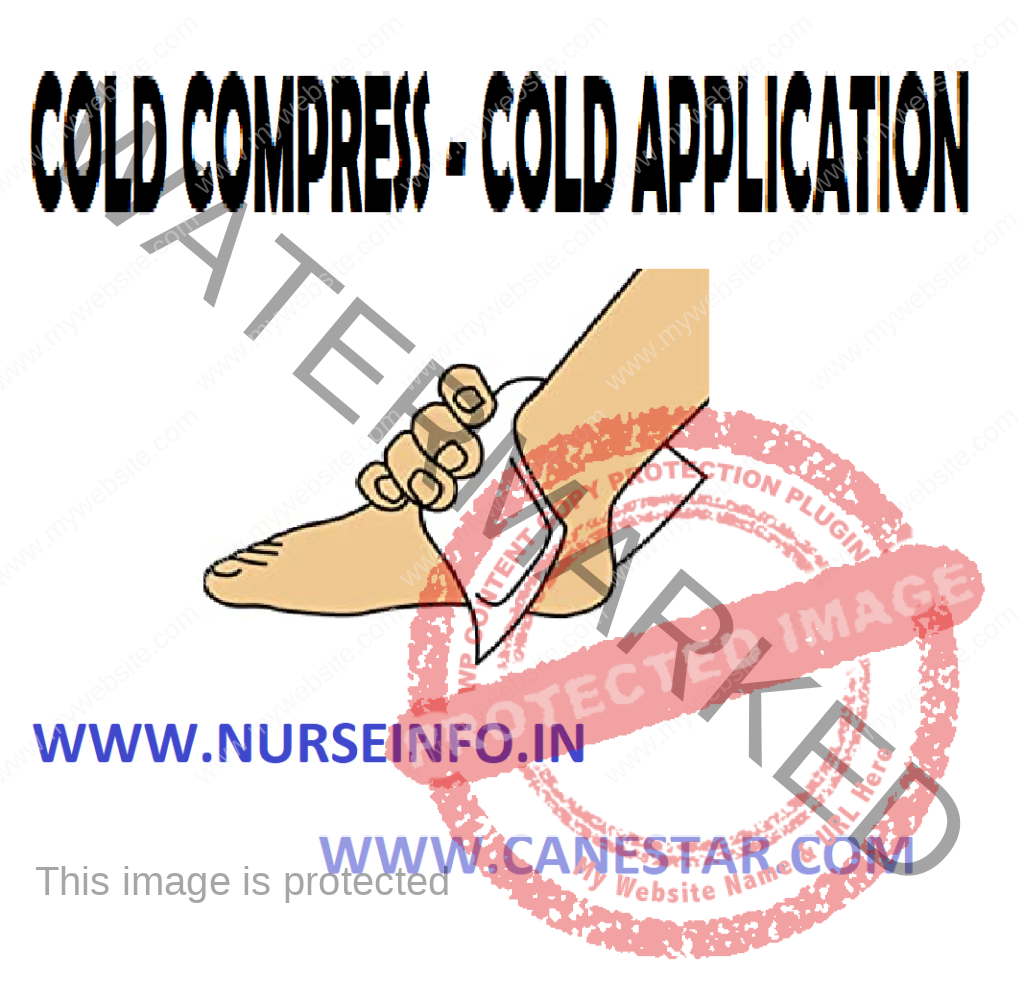COLD COMPRESS (Cold Application) – Definition, Purpose, General Instructions, Preliminary Assessment Check, Effects, Physiologic Effects, Indications, Preparation of the Patient and Environment, Equipment, Procedure, After Care and Contraindications

Updated 2024
Cold
compress is a local moist cold moist application made out of folded layers of
gauze, lint piece or old soften linen, wring out of cold or ice water or in
some evaporating lotion.

DEFINITION
A cloth
wrung from cold or ice water which may be applied to any part of the body.

PURPOSE
- To provide comfort
- To reduce body temperature
- To reduce inflammation and edema
- To relieve pain, burning sensation
and irritation - To anesthetize for short time
- To control hemorrhage
- To inhibit bacterial growth and thus
prevent suppuration
GENERAL INSTRUCTIONS
- Application of cold compress over the
skin helps in conduction of heat - Cold application beyond 20 minutes
leads to secondary effects - Check the temperature every 15
minutes, it helps in detection of any variations in the body temperature
PRELIMINARY ASSESSMENT CHECK
- The doctor order for any specific
instruction - General condition and diagnosis of
the patient - Self-care ability of the patient
- Assess for the need of cold
applications - Frequency and duration of application
- For any contraindication of cold
application - Articles available in the unit
EFFECTS
To prevent
the depression that often occurs following heating treatments. The most
effective form of cold compress is a small towel wrapped around the head like a
turban during the treatment. The same receptors, or special nerve endings,
which serve to convey stimuli to the blood vessels and nerve endings, hence to
all the organs reflex connected with them, are affected as much by cold
applications as by hot. The more intense is the stimulation, the greater the
reaction.
PHYSIOLOGIC EFFECTS
- To decrease blood flow locally and distally
- To prevent and relieve congestion
- For relief of pain due to edema
and/or trauma - If applied over the heart: will slow
the heart rate, increase the force and raise the arterial blood pressure - To increase the reflect effect of
thermal applications by increasing the difference between hot and cold; an
example is using the cold compress following a fomentation.
INDICATIONS
- Throbbing pain due to edema or
trauma, such as sprains - Fevers
- Congestion in the face and
head-sinusitis and head-ache (use with a hot foot bath) - As a precordial compress in
tachycardia-fast heartbeat (more than 100 beats/min) - May be applied as a turban to the
head or cravat to the neck with general applications of heat - Headache-apply cold compress to head
while using a hot foot bath - Passive chest congestion in lung
problems, together with fomentations
PREPARATION OF THE PATIENT AND ENVIRONMENT
- Explain the procedure to the patients
- Arrange the articles at the bedside
- Provide privacy
- Place the patient in a comfortable
position - Bring the patient to the edge of the
bed - Place the Mackintosh and towel under
the patient to protect the bed
EQUIPMENT
A clean tray containing:
- Bowel with ice water
- Folded gauze pieces in a bowl
- Mackintosh and towel
- Small cotton balls in a bowl
- Thermometer tray
PROCEDURE
- Wash hands
- Pack the ear with cotton balls if
compress is to be applied to forehead - Take the gauze pieces immerse it in
the water wring it - Make sure that there is not dripping
of water and apply it to the part ordered - Change it as soon as it becomes warm
- Check the temperature every 15
minutes - Keep a constant watch on the color of
the skin. Test the skin for numbness
AFTER CARE
- When the time is over, remove the
compress - Wipe the part and make the patient
comfortable - Take out the cotton balls from the
ears - Inspect the part for discoloration or
numbness - Place the patient in a comfortable
position - Check the vital signs end of the
treatment - Replace the articles after cleaning
- Wash hands
- Record the procedure in nurse’s
record sheet - Record the vital signs in TPR sheet
CONTRAINDICATIONS
- Diabetes use with caution
- Local skin inflammation
- Patients who cannot tolerate cold
- Patient who is chilled – wait until
the entire body is warm

NURSING PROCEDURES LIST CLICK HERE
NURSING IMPORTANT QUESTIONS – CLICK HERE

Discover more from Bibliobazar Digi Books
Subscribe to get the latest posts sent to your email.



